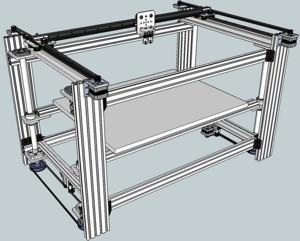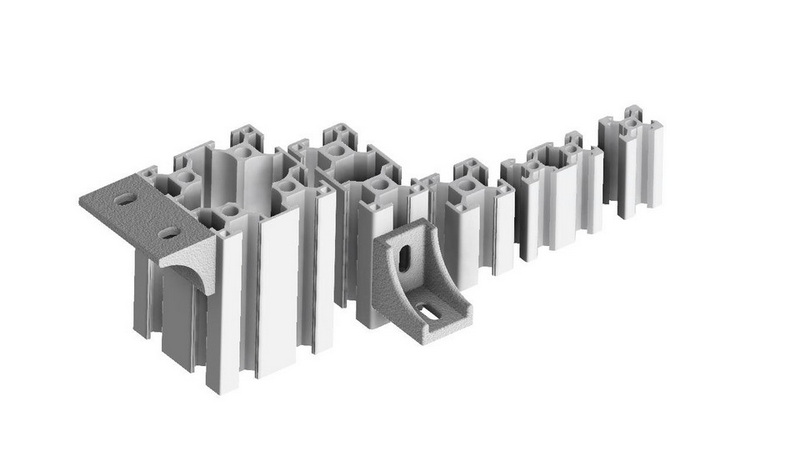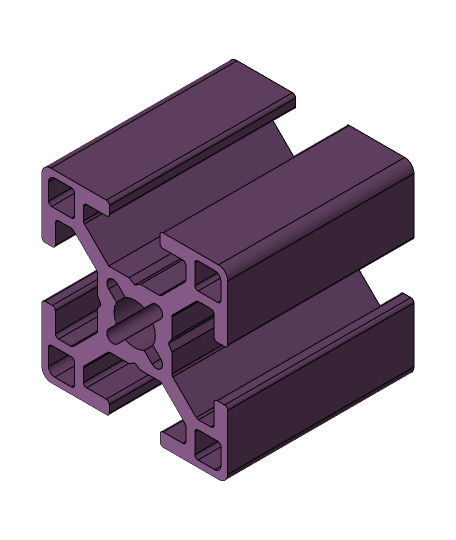Content Menu
● Understanding Aluminum Extrusion
● Best Practices for Designing Aluminum Extrusion 3D Models
● Tools and Software for Designing Aluminum Extrusion 3D Models
● Common Mistakes to Avoid
● Case Studies of Successful Aluminum Extrusion Designs
● Conclusion
● Related Questions
>> 1. What are the benefits of using aluminum extrusion in manufacturing?
>> 2. How do I choose the right aluminum alloy for my extrusion project?
>> 3. Can aluminum extrusions be easily modified after production?
>> 4. What industries commonly use aluminum extrusion?
>> 5. How does temperature affect the aluminum extrusion process?
Aluminum extrusion is a widely used manufacturing process that allows for the creation of complex shapes and profiles. This method is particularly beneficial in industries ranging from construction to automotive, owing to the lightweight yet sturdy nature of aluminum. When designing aluminum extrusion 3D models, following best practices can significantly enhance the efficiency and effectiveness of the final product. This article will delve into these best practices, supported by visuals and videos to provide a comprehensive understanding.

Understanding Aluminum Extrusion
Aluminum extrusion involves forcing aluminum alloy through a die to create a specific cross-sectional profile. This process can produce solid, hollow, or semi-hollow shapes, which are then used in various applications. The flexibility of aluminum extrusion allows designers to create shapes tailored to specific needs, optimizing both functionality and aesthetics.
Aluminum Extrusion Process
The extrusion process begins with heating aluminum billets until they reach a malleable state. The heated aluminum is then pushed through a die using a hydraulic press, forming the desired shape as it exits the die. Once extruded, the material is cooled and cut to length. This method not only allows for intricate designs but also ensures uniformity in production.
Best Practices for Designing Aluminum Extrusion 3D Models
1. Prioritize Functionality and Aesthetics
When designing an aluminum extrusion 3D model, the first step is to clearly define its purpose. Consider how the shape will be used and what functional requirements it must meet. The design should not only fulfill these functional needs but also align with aesthetic preferences.
- Functional Requirements: Ensure that the design supports necessary loads and stresses. For instance, in structural applications, the model must withstand bending and shear forces without failure.
- Aesthetic Considerations: Incorporate visual elements that enhance the product's appeal. A well-designed aluminum extrusion can serve as both a functional component and an eye-catching element in architectural designs.
2. Optimize Shape Configuration
The configuration of the shape is crucial in maximizing performance. Aluminum extrusions can be categorized into solid, hollow, and semi-hollow shapes. Each category has its advantages:
- Solid Shapes: Offer maximum strength and are suitable for load-bearing applications. These shapes are often used in beams or supports where structural integrity is paramount.
- Hollow Shapes: Provide lightweight solutions while maintaining structural integrity. Hollow profiles are commonly used in applications where weight reduction is critical without sacrificing strength.
- Semi-Hollow Shapes: Combine benefits from both solid and hollow profiles, allowing for versatility in design while optimizing material usage.
Selecting the right shape configuration can lead to significant cost savings during production and improved performance in application.
3. Maintain Uniform Wall Thickness
Uniform wall thickness is essential for ensuring consistent cooling during the extrusion process. Variations in thickness can lead to warping or dimensional inaccuracies. Aim for a minimum wall thickness that meets structural requirements while avoiding excessively thin sections that could compromise strength.
- Minimum Thickness Guidelines: Generally, a wall thickness of at least 1/16 inch (1.5 mm) is recommended for most applications; however, specific requirements may vary based on design and load conditions.
4. Smooth Transitions
To prevent stress concentrations that could lead to failure, all transitions between different sections of the model should be smooth. Implement generous radii at thick-thin junctions and avoid sharp corners or knife edges.
- Designing for Strength: Utilizing fillets or rounded edges can help distribute stress more evenly throughout the profile, reducing the likelihood of cracking or failure under load.
5. Consider Tolerances and Clearances
Understanding tolerances is vital for ensuring that parts fit together correctly after fabrication. Design with appropriate clearances to accommodate any potential expansion or contraction of materials during temperature changes.
- Tolerance Standards: Familiarize yourself with industry standards such as ISO or ANSI tolerances to ensure your designs meet necessary specifications for assembly and functionality.
Tools and Software for Designing Aluminum Extrusion 3D Models
Using the right tools can significantly improve design accuracy and efficiency:
- CAD Software: Programs like SolidWorks or AutoCAD are invaluable for creating precise 3D models. These software solutions offer features such as parametric modeling and simulation capabilities that allow designers to visualize their projects effectively.
- Simulation Tools: These tools help predict how the design will behave under various conditions, allowing for adjustments before manufacturing. Finite Element Analysis (FEA) software can simulate stress distribution within your model, providing insights into potential weak points that may need reinforcement.
- Rendering Software: Tools like KeyShot or Blender can create photorealistic renderings of your designs, aiding in presentations or marketing efforts by showcasing how your product will look once manufactured.

Common Mistakes to Avoid
While designing aluminum extrusion 3D models, it's crucial to avoid common pitfalls:
- Ignoring Material Properties: Understanding the specific alloy's properties is essential for effective design. Different alloys have varying strengths, corrosion resistance, and thermal conductivity that should influence your design choices.
- Overcomplicating Designs: Simplicity often leads to better manufacturability and lower costs. Avoid unnecessary complexity that may complicate production processes or increase material waste.
- Neglecting Post-Processing Needs: Consider how your model will be finished after extrusion—whether it will require machining, anodizing, or painting—and incorporate these needs into your initial design phase.
Case Studies of Successful Aluminum Extrusion Designs
To illustrate best practices in action, let's explore some notable case studies where effective aluminum extrusion designs have made significant impacts:
- Architectural Applications: Many modern buildings utilize aluminum extrusions for window frames and facades due to their lightweight nature and ability to resist corrosion over time. For example, the use of large hollow extrusions allows architects to create expansive glass walls without compromising structural integrity.
- Automotive Industry Innovations: The automotive sector has increasingly adopted aluminum extrusions in vehicle frames to reduce weight while enhancing fuel efficiency without sacrificing safety standards. Companies like Tesla have integrated custom aluminum extrusions into their vehicle designs to optimize performance while maintaining aesthetic appeal.
Conclusion
Designing effective aluminum extrusion 3D models requires careful consideration of functionality, aesthetics, material properties, and manufacturing processes. By adhering to best practices such as optimizing shape configuration, maintaining uniform wall thicknesses, ensuring smooth transitions, and understanding tolerances, designers can create efficient and robust structures tailored to their specific needs.
The flexibility offered by aluminum extrusion combined with thoughtful design practices can lead to innovative solutions across various industries—from architecture to automotive engineering—demonstrating its vital role in modern manufacturing.

Related Questions
1. What are the benefits of using aluminum extrusion in manufacturing?
Aluminum extrusion offers lightweight yet strong materials ideal for various applications, flexibility in design, cost-effectiveness due to reduced waste during production, excellent corrosion resistance, and recyclability of materials.
2. How do I choose the right aluminum alloy for my extrusion project?
Selecting an alloy depends on factors like strength requirements, corrosion resistance, thermal conductivity needs, and intended application—common alloys include 6061 for structural applications due to its excellent mechanical properties and weldability or 6063 for architectural applications due to its good surface finish characteristics.
3. Can aluminum extrusions be easily modified after production?
Yes, aluminum extrusions can be cut, drilled, or welded post-production without significant loss of structural integrity; this allows for customization in assembly or design adjustments as needed during installation or fabrication processes.
4. What industries commonly use aluminum extrusion?
Industries such as construction (for window frames), automotive (for lightweight vehicle components), aerospace (for structural elements), consumer goods (for packaging), electronics (for heat sinks), and furniture (for frames) frequently utilize aluminum extrusion due to its versatility and performance characteristics.
5. How does temperature affect the aluminum extrusion process?
Temperature plays a crucial role in determining material flow during extrusion; maintaining optimal temperatures ensures better quality profiles with fewer defects while also influencing mechanical properties post-extrusion—too high temperatures may lead to oxidation while too low could result in poor flow characteristics during processing.






















